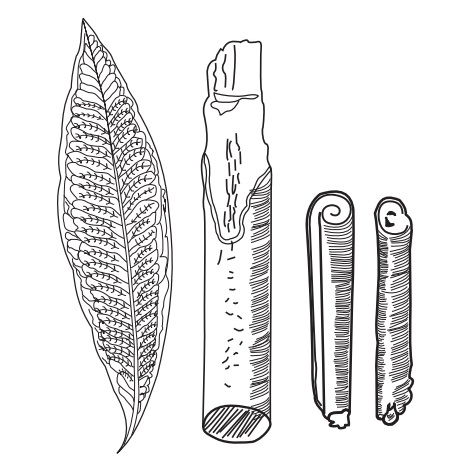Cinnamon
| Home | | Pharmacognosy |Chapter: Pharmacognosy and Phytochemistry : Drugs Containing Volatile Oils
Cinnamon is the dried inner bark of the coppiced shoots of Cinnamomum zeylanicum Nees., belonging to family Lauraceae.
CINNAMON
Synonyms
Cortex cinnamoni, Ceylon cinnamon, Saigon cinnamon, Chinese
cassia, Cinnamomum aromaticum, Cinnamomum
laurus.
Biological Source
Cinnamon is the dried inner bark of the coppiced shoots of Cinnamomum zeylanicum Nees., belonging
to family Lauraceae.
Geographical Sources
Cinnamomum zeylanicum is widely cultivated in Ceylon, Java, Sumatra, West Indies, Brazil,
Mauritius, Jamaica, and India.
Cultivation and Collection
Cinnamon is cultivated by seed propagation method, about
four to five seeds are placed in each hole at 2 m distance between the plants.
The tree grows best in almost pure requiring only 1% of vegetable substance. It
prefers shelter and constant rain of 75” to rainfall. Cinnamon is an ever-green
tree grows from 20 to 30 feet high, has thick scabrous bark, strong branches.
The field is kept away from weeds and the plant is coppiced few inches above
the ground, leaving five to six straight shoots on them. The bark is loosened
and the longitudinal incisions are made using copper or brass knife. The barks
arc stripped off and made into bundles and wrapped in Coir. The bundles are
kept aside for about 2 hours to facilitate fermentation due to enzymatic
action. The fermentation helps in the loosening of the outer layer up to pericycle.
Each strip is taken and then they are scraped using a knife to separate the
cork. The pieces are dried and they are categorized and packed one inside the
other. Then compound quills are made by packing the small, quills into larger
ones. They are cut into pieces of 1 m length and dried first under shade and
later under sun. During drying, the original pale colour changes to brown due
to the presence of some pholobatannins in the bark
Characteristics
Cinnamon are either in single- or double-compound quills,
with a size of 1 m length, 0.5 mm thickness, and 6 to 10 mm diameter. The outer
surface has yellowish brown colour having longitudinal lines of pericyclic
fibre and scars and holes representing the position of leaves or the lateral
shoots. The inner surface is darker than the outer. Cinnamon has a fragrant
perfume; taste aromatic and sweet.

Microscopy
The transverse section shows the presence of three to four
layers of sclereids which are horse shoe shaped consisting of starch grains.
The pericyclic fibres (6 to 15) are present on the outer margin. It consists of
sieve tubes which are completely collapsed and are arranged tangentially;
lignified phloem fibres, arranged as tangential rows of four to five cells;
biseriate medullary rays with needle-shaped calcium oxalate crystals;
longitudinally elongated idioblast consisting of volatile oil; sub-rectangular
parenchyma cells with starch grains and calcium oxalate crystals.


Transverse section of Cinnamon bark
Chemical Constituents
Cinnamon contains about 10% of volatile oil, tannin,
mucilage, calcium oxalate and sugar. Volatile oil contains 50 to 65% cinnamic
aldehyde, along with 5 to 10% eugenol, terpene hydrocarbons and small
quantities of ketones and alcohols.

Chemical Tests
1. A drop of volatile oil is dissolved
in 5 ml of alcohol and to it a drop of ferric chloride is added, A pale green
colour is produced. Cinnamic aldehyde gives brown colour with ferric chloride,
whereas eugenol gives blue colour.
2. The alcoholic extract is treated
with phenylhydrazine hydrochloride, it produces red colour due to the
formation of phenylhydrazone of cinnamic aldehyde.
Uses
It is used as an alterative, aromatic, carminative,
flavouring agent, analgesic, antiseptic, antirheumatic, antispasmodic,
demulcent, digestive, expectorant, stomachic, diaphoretic, antibacterial,
antifungal, etc. It stops vomiting, relieves flatulence and is given with chalk
and as astringents for diarrhoea and haemorrhage of the womb. It is also used
in the treatment of bronchitis, colds, palpitations, nausea, congestion, and
liver problems.
Other Species
Cinnamon cassia is often used as a substituent. C. culiawan is native of Amboyna and
the bark has the flavour of clove, C.
iners, Cassia burmarin, Saigon cinnamon, and C. nitidum are also used.
Marketed Products
It is one of the ingredients of the preparations known as
Rumalaya gel, Koflet lozenges, Chyavanprash (Himalaya Drug Company), Garbhapal
ras, Sutsekhar ras (Dabur), and Sage Staminex capsules (Sage Herbals).
